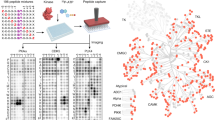Abstract
Kinases play a pivotal role in propagating the phosphorylation-mediated signaling networks in living cells. With the overwhelming quantities of phosphoproteomics data being generated, the number of identified phosphorylation sites (phosphosites) is ever increasing. Often, proteomics investigations aim to understand the global signaling modulation that takes place in different biological conditions investigated. For phosphoproteomics data, identifying the kinases central to mediating this response is key. This has prompted several efforts to catalogue the immense amounts of phosphorylation data and known or predicted kinases responsible for the modifications. However, barely 20 % of the known phosphosites are assigned to a kinase, initiating various bioinformatics efforts that attempt to predict the responsible kinases. These algorithms employ different approaches to predict kinase consensus sequence motifs, mostly based on large scale in vivo and in vitro experiments. The context of the kinase and the phosphorylated proteins in a biological system is equally important for predicting association between the enzymes and substrates, an aspect that is also being tackled with available bioinformatics tools. This chapter summarizes the use of the larger phosphorylation databases, and approaches that can be applied to predict kinases that phosphorylate individual sites or that are globally modulated in phosphoproteomics datasets.
Access this chapter
Tax calculation will be finalised at checkout
Purchases are for personal use only
Similar content being viewed by others
References
Olsen JV et al (2010) Quantitative phosphoproteomics reveals widespread full phosphorylation site occupancy during mitosis. Sci Signal 3(104):ra3
Sharma K et al (2014) Ultradeep human phosphoproteome reveals a distinct regulatory nature of Tyr and Ser/Thr-based signaling. Cell Rep 8(5):1583–1594
Manning G et al (2002) The protein kinase complement of the human genome. Science 298(5600):1912–1934
Dinkel H et al (2011) Phospho.ELM a database of phosphorylation sites--update 2011. Nucleic Acids Res 39(Database issue):D261–D267
Rask-Andersen M et al (2014) Advances in kinase targeting: current clinical use and clinical trials. Trends Pharmacol Sci 35(11):604–620
Hornbeck PV et al (2012) PhosphoSitePlus: a comprehensive resource for investigating the structure and function of experimentally determined post-translational modifications in man and mouse. Nucleic Acids Res 40(Database issue):D261–D270
Gnad F, Gunawardena J, Mann M (2011) PHOSIDA 2011: the posttranslational modification database. Nucleic Acids Res 39(Database issue):D253–D260
Gnad F et al (2007) PHOSIDA (phosphorylation site database): management, structural and evolutionary investigation, and prediction of phosphosites. Genome Biol 8(11):R250
Olsen JV et al (2006) Global, in vivo, and site-specific phosphorylation dynamics in signaling networks. Cell 127(3):635–648
Miller ML et al (2008) Linear motif atlas for phosphorylation-dependent signaling. Sci Signal 1(35):2
Yaffe MB et al (2001) A motif-based profile scanning approach for genome-wide prediction of signaling pathways. Nat Biotechnol 19(4):348–353
Obenauer JC, Cantley LC, Yaffe MB (2003) Scansite 2.0: proteome-wide prediction of cell signaling interactions using short sequence motifs. Nucleic Acids Res 31(13):3635–3641
Songyang Z et al (1994) Use of an oriented peptide library to determine the optimal substrates of protein kinases. Curr Biol 4(11):973–982
Horn H et al (2014) KinomeXplorer: an integrated platform for kinome biology studies. Nat Methods 11(6):603–604
Linding R et al (2007) Systematic discovery of in vivo phosphorylation networks. Cell 129(7):1415–1426
Franceschini A et al (2013) STRING v9.1: protein-protein interaction networks, with increased coverage and integration. Nucleic Acids Res 41(Database issue):D808–D815
Cox J, Mann M (2008) MaxQuant enables high peptide identification rates, individualized p.p.b.-range mass accuracies and proteome-wide protein quantification. Nat Biotechnol 26(12):1367–1372
Acknowledgments
This work was in part funded by the Novo Nordisk Foundation Center for Protein Research [NNF14CC0001].
Author information
Authors and Affiliations
Corresponding author
Editor information
Editors and Affiliations
Rights and permissions
Copyright information
© 2016 Springer Science+Business Media New York
About this protocol
Cite this protocol
Munk, S., Refsgaard, J.C., Olsen, J.V., Jensen, L.J. (2016). From Phosphosites to Kinases. In: von Stechow, L. (eds) Phospho-Proteomics. Methods in Molecular Biology, vol 1355. Springer, New York, NY. https://doi.org/10.1007/978-1-4939-3049-4_21
Download citation
DOI: https://doi.org/10.1007/978-1-4939-3049-4_21
Publisher Name: Springer, New York, NY
Print ISBN: 978-1-4939-3048-7
Online ISBN: 978-1-4939-3049-4
eBook Packages: Springer Protocols




